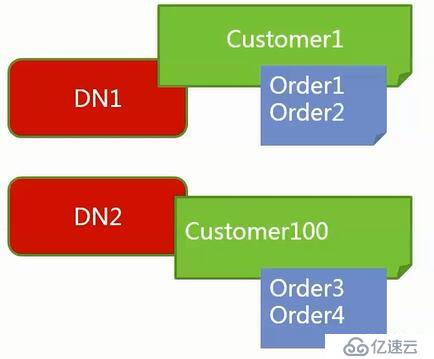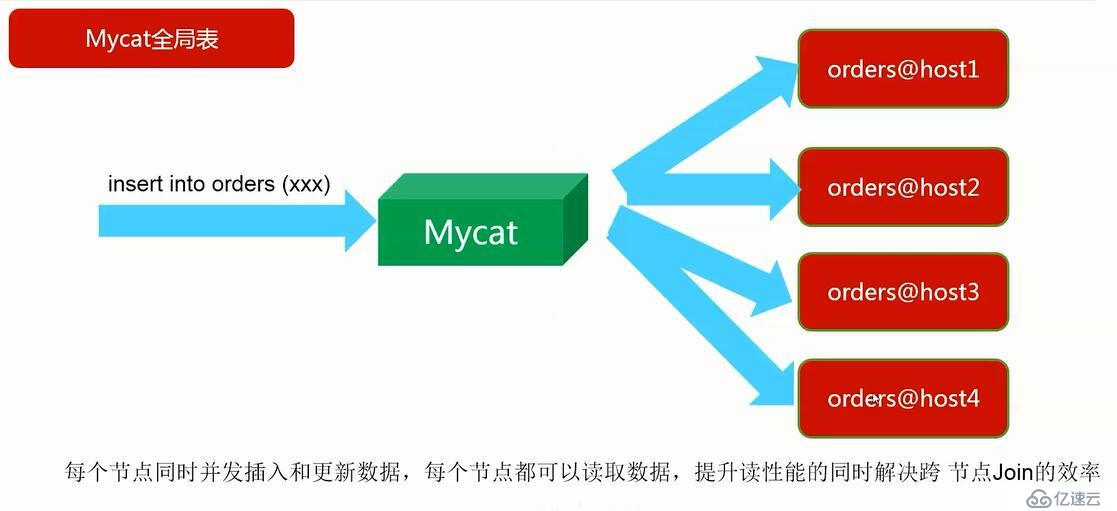您好,登錄后才能下訂單哦!
您好,登錄后才能下訂單哦!
一、Mycat分庫路由分為連續路由和離散路由。
1、連續路由:
(1)、常用的路由方式:auto-sharding-long、sharding-by-date、sharding-by-month
(2)、優點:擴容無需遷移數據;范圍條件查詢消耗資源少。
(3)、缺點:存在數據熱點的可能性;并發訪問能力受限于單一或少量的DataNode
2、離線路由:
(1)、常用的路由方式:sharding-by-intfile、sharding-by-murmur、mod-long(取模)、crc32slot(取模)
(2)、優點:并發訪問能力增強。
(3)、缺點:數據擴容比較困難,涉及到數據遷移問題;數據庫鏈接消耗資源多。
二、auto-sharding-long:
1、路由規則:
<tableRule name="auto-sharding-long-userid">
<rule>
<columns>userid</columns>
<algorithm>rang-long-userid</algorithm>
</rule>
</tableRule>
<function name="rang-long-userid"
class="io.mycat.route.function.AutoPartitionByLong">
<property name="mapFile">autopartition-long-userid.txt</property>
</function>
[root@host01 conf]# more autopartition-long-userid.txt
# range start-end ,data node index
# K=1000,M=10000.
0-1000=0
1001-2000=1
2001-3000=2
3001-4000=3
4001-5000=4
5001-6000=5
2、例子:
CREATE TABLE tb_user_detail_t (
userid bigint not null primary key,
name varchar(64) DEFAULT NULL,
createtime datetime DEFAULT CURRENT_TIMESTAMP,
moditytime datetime DEFAULT CURRENT_TIMESTAMP
) ENGINE=InnoDB DEFAULT CHARSET=utf8;
寫入數據
insert into tb_user_detail_t(userid,name) values(999,'name999');
insert into tb_user_detail_t(userid,name) values(1999,'name999');
insert into tb_user_detail_t(userid,name) values(2999,'name999');
insert into tb_user_detail_t(userid,name) values(3999,'name999');
insert into tb_user_detail_t(userid,name) values(4999,'name999');
insert into tb_user_detail_t(userid,name) values(5999,'name999');
三、sharding-by-date:
1、路由規則:
<tableRule name="sharding-by-date-test">
<rule>
<columns>createtime</columns>
<algorithm> partbydate </algorithm>
</rule>
</tableRule>
<function name=" partbydate" class="io.mycat.route.function.PartitionByDate">
<property name="dateFormat"> yyyy-MM-dd HH:mm:ss </property>
<property name="sBeginDate">2016-01-01 00:00:00</property>
<property name="sPartionDay">2</property>
</function>
分片日期從2016-01-01開始,每2天一個分片。
2、例子:
CREATE TABLE `tb_user_partbydate` (
`id` varchar(32) NOT NULL,
`name` varchar(64) DEFAULT NULL,
`createtime` varchar(10)
) ENGINE=InnoDB DEFAULT CHARSET=utf8;
insert into tb_user_partbydate (id,name,createtime) values('a0001','name1','2016-01-01 00:01:00');
insert into tb_user_partbydate (id,name,createtime) values('a0002','name1','2016-01-02 00:01:00');
insert into tb_user_partbydate (id,name,createtime) values('a0003','name1','2016-01-03 00:01:00');
insert into tb_user_partbydate (id,name,createtime) values('a0004','name1','2016-01-04 00:01:00');
insert into tb_user_partbydate (id,name,createtime) values('a0005','name1','2016-01-05 00:01:00');
insert into tb_user_partbydate (id,name,createtime) values('a0006','name1','2016-01-06 00:01:00');
insert into tb_user_partbydate (id,name,createtime) values('a0007','name1','2016-01-07 00:01:00');
insert into tb_user_partbydate (id,name,createtime) values('a0005','name1','2016-01-08 00:01:00');
insert into tb_user_partbydate (id,name,createtime) values('a0006','name1','2016-01-09 00:01:00');
insert into tb_user_partbydate (id,name,createtime) values('a0007','name1','2016-01-10 00:01:00');
四、sharding-by-month:
1、路由規則:
<tableRule name="sharding-by-month">
<rule>
<columns>createtime</columns>
<algorithm>partbymonth</algorithm>
</rule>
</tableRule>
<function name="partbymonth"
class="io.mycat.route.function.PartitionByMonth">
<property name="dateFormat">yyyy-MM-dd HH:mm:ss</property>
<property name="sBeginDate">2015-01-01 00:00:00</property>
</function>
dateFormat為日期格式,sBeginDate為開始日期。
2、例子:
CREATE TABLE ` tb_partbymonth ` (
`id` varchar(32) NOT NULL,
`name` varchar(64) DEFAULT NULL,
`createtime` datetime DEFAULT CURRENT_TIMESTAMP
) ENGINE=InnoDB DEFAULT CHARSET=utf8;
寫入數據(注意這里不能使用now函數)
insert into tb_partbymonth(id,name,createtime) values('a0001','name1','2015-01-01 10:00:00');
insert into tb_partbymonth(id,name,createtime) values('a0002','name1','2015-02-02 10:00:00');
insert into tb_partbymonth(id,name,createtime) values('a0003','name1','2015-03-01 00:00:00');
insert into tb_partbymonth(id,name,createtime) values('a0004','name1','2015-04-01 00:00:00');
insert into tb_partbymonth(id,name,createtime) values('a0005','name1','2015-05-01 10:00:00');
insert into tb_partbymonth(id,name,createtime) values('a0006','name1','2015-06-02 10:00:00');
insert into tb_partbymonth(id,name,createtime) values('a0007','name1','2015-07-01 00:00:00');
insert into tb_partbymonth(id,name,createtime) values('a0008','name1','2015-08-01 00:00:00');
insert into tb_partbymonth(id,name,createtime) values('a0009','name1','2015-09-01 10:00:00');
insert into tb_partbymonth(id,name,createtime) values('a0010','name1','2015-10-02 10:00:00');
insert into tb_partbymonth(id,name,createtime) values('a0011','name1','2015-11-01 00:00:00');
insert into tb_partbymonth(id,name,createtime) values('a0012','name1','2015-12-01 00:00:00');
insert into tb_partbymonth(id,name,createtime) values('a0013','name1','2016-01-01 00:00:00');
五、sharding-by-intfile(枚舉):
1、路由規則:
<tableRule name="sharding-by-intfile-provcode">
<rule>
<columns>provcode</columns>
<algorithm>hash-int-provcode</algorithm>
</rule>
</tableRule>
<function name="hash-int-provcode"
class="io.mycat.route.function.PartitionByFileMap">
<property name="mapFile">partition-hash-int-provcode.txt</property>
<property name="type">0</property>
</function>
type=0 代表×××
type=1 代表字符串類型
[root@host01 conf]# more partition-hash-int-provcode.txt
1=0
2=1
3=2
4=3
5=4
6=5
7=0
8=1
9=2
10=3
11=4
12=5
DEFAULT_NODE=0 ##找不到省份匹配的情況下,默認放到數據庫1
這里是6個庫,序號0-5,將不同的省份映射到對應的庫。所有的省份和庫哦對應關系都要枚舉出來。
2、例子:
CREATE TABLE `tb_user_t` (
id bigint auto_increment not null primary key,
`name` varchar(64) DEFAULT NULL,
provcode int ,
`createtime` datetime DEFAULT CURRENT_TIMESTAMP,
`moditytime` datetime DEFAULT CURRENT_TIMESTAMP
) ENGINE=InnoDB DEFAULT CHARSET=utf8;
發現分庫情況下定義自動增長的id不管用,因為每個庫都有自己的自增長id,通過mycat查詢的話會有重復的id.
如下:
mysql> select * from tb_user_t order by id;
+----+----------+----------+---------------------+---------------------+
| id | name | provcode | createtime | moditytime |
+----+----------+----------+---------------------+---------------------+
| 1 | name0005 | 5 | 2017-08-09 10:54:44 | 2017-08-09 10:54:44 |
| 1 | name0001 | 1 | 2017-08-09 10:54:44 | 2017-08-09 10:54:44 |
| 1 | name0004 | 4 | 2017-08-09 10:54:44 | 2017-08-09 10:54:44 |
| 1 | name0002 | 2 | 2017-08-09 10:54:44 | 2017-08-09 10:54:44 |
| 1 | name0003 | 3 | 2017-08-09 10:54:44 | 2017-08-09 10:54:44 |
| 1 | name0006 | 6 | 2017-08-09 10:54:44 | 2017-08-09 10:54:44 |
| 2 | name0011 | 11 | 2017-08-09 10:54:53 | 2017-08-09 10:54:53 |
| 2 | name0007 | 7 | 2017-08-09 10:54:53 | 2017-08-09 10:54:53 |
| 2 | name0010 | 10 | 2017-08-09 10:54:53 | 2017-08-09 10:54:53 |
| 2 | name0008 | 8 | 2017-08-09 10:54:53 | 2017-08-09 10:54:53 |
| 2 | name0009 | 9 | 2017-08-09 10:54:53 | 2017-08-09 10:54:53 |
| 2 | name0012 | 12 | 2017-08-09 10:54:53 | 2017-08-09 10:54:53 |
| 3 | name0013 | 13 | 2017-08-09 11:12:17 | 2017-08-09 11:12:17 |
+----+----------+----------+---------------------+---------------------+
六、sharding-by-murmur:
murmur算法是將字段進行hash后分發到不同的數據庫,字段類型支持int和varchar.
1、路由規則:
<tableRule name="sharding-by-murmur-userid">
<rule>
<columns>userid</columns>
<algorithm>murmur</algorithm>
</rule>
</tableRule>
<function name="murmur"
class="io.mycat.route.function.PartitionByMurmurHash">
<property name="seed">0</property><!-- 默認是0 -->
<property name="count">6</property><!-- 要分片的數據庫節點數量,必須指定,否則沒法分片 -->
<property name="virtualBucketTimes">160</property><!-- 一個實際的數據庫節點被映射為這么多虛擬節點,默認是160倍,也就是虛擬節點數是物理節點數的160倍 -->
<!-- <property name="weightMapFile">weightMapFile</property> 節點的權重,沒有指定權重的節點默認是1。以properties文件
的格式填寫,以從0開始到count-1的整數值也就是節點索引為key,以節點權重值為值。所有權重值必須是正整數,否則以1代替 -->
<!-- <property name="bucketMapPath">/etc/mycat/bucketMapPath</property>
用于測試時觀察各物理節點與虛擬節點的分布情況,如果指定了這個屬性,會把虛擬節點的murmur hash值與物理節點的映
射按行輸出到這個文件,沒有默認值,如果不指定,就不會輸出任何東西 -->
</function>
2、例子:
CREATE TABLE `tb_user_murmur_string_t` (
`userid` varchar(32) NOT NULL,
`name` varchar(64) DEFAULT NULL,
`createtime` datetime DEFAULT CURRENT_TIMESTAMP,
`moditytime` datetime DEFAULT CURRENT_TIMESTAMP,
PRIMARY KEY (`userid`)
) ENGINE=InnoDB DEFAULT CHARSET=utf8;
寫入數據
insert into tb_user_murmur_string_t(userid,name) values('user002','name002');
insert into tb_user_murmur_string_t(userid,name) values('user003','name003');
insert into tb_user_murmur_string_t(userid,name) values('user004','name004');
insert into tb_user_murmur_string_t(userid,name) values('user005','name005');
insert into tb_user_murmur_string_t(userid,name) values('user006','name006');
insert into tb_user_murmur_string_t(userid,name) values('user007','name007');
insert into tb_user_murmur_string_t(userid,name) values('user008','name008');
insert into tb_user_murmur_string_t(userid,name) values('user009','name009');
insert into tb_user_murmur_string_t(userid,name) values('user010','name010');
七、crc32slot:
crs32算法,分庫字段類型支撐int和varchar.
1、路由規則:
<tableRule name="crc32slot">
<rule>
<columns>id</columns>
<algorithm>crc32slot</algorithm>
</rule>
</tableRule>
<function name="crc32slot" class="io.mycat.route.function.PartitionByCRC32PreSlot">
<property name="count">6</property><!-- 要分片的數據庫節點數量,必須指定,否則沒法分片 -->
</function>
count=6指定需要分庫的個數.
2、例子:
CREATE TABLE `tb_user_crc32slot_t` (
`id` varchar(32) NOT NULL,
`name` varchar(64) DEFAULT NULL,
`createtime` datetime DEFAULT CURRENT_TIMESTAMP,
`moditytime` datetime DEFAULT CURRENT_TIMESTAMP
) ENGINE=InnoDB DEFAULT CHARSET=utf8;
寫入數據:
insert into tb_user_crc32slot_t(id,name) values('a0002','name1');
insert into tb_user_crc32slot_t(id,name) values('a0003','name1');
insert into tb_user_crc32slot_t(id,name) values('a0004','name1');
insert into tb_user_crc32slot_t(id,name) values('a0005','name1');
insert into tb_user_crc32slot_t(id,name) values('a0006','name1');
insert into tb_user_crc32slot_t(id,name) values('a0007','name1');
insert into tb_user_crc32slot_t(id,name) values('a0008','name1');
insert into tb_user_crc32slot_t(id,name) values('a0009','name1');
insert into tb_user_crc32slot_t(id,name) values('a0010','name1');
insert into tb_user_crc32slot_t(id,name) values('a0011','name1');
insert into tb_user_crc32slot_t(id,name) values('a0012','name1');
insert into tb_user_crc32slot_t(id,name) values('a0013','name1');
insert into tb_user_crc32slot_t(id,name) values('a0014','name1');
insert into tb_user_crc32slot_t(id,name) values('a0015','name1');
八、mod-long:
1、路由規則:對十進制數進行按照節點取模。
<tableRule name="mod-long">
<rule>
<columns>id</columns>
<algorithm>mod-long</algorithm>
</rule>
</tableRule>
<function name="mod-long" class="io.mycat.route.function.PartitionByMod">
<property name="count">3</property>
<!-- 要分片的數據庫節點數量,必須指定,否則沒法分片,即對十進制數進行按照節點取模,將數據離散的分散到各個數據節點上 -->
</function>
九、mycat分庫規則E/R規則 :
1、路由規則:
E/R規則通過childTable設定之后,父子表相同的Id會落在相同的庫,這樣的避免關聯的時候跨庫進行關聯.
joinKey="order_id" 是子表的order_id字段
parentKey="id" 是父表的id字段
即子表通過order_id字段跟父表的id字段進行關聯

2、例子
(2.1)、創建表語句:
create table orders
(
id int not null,
order_name varchar(64),
createtime datetime DEFAULT CURRENT_TIMESTAMP,
moditytime datetime DEFAULT CURRENT_TIMESTAMP,
PRIMARY KEY (id)
);
create table orders_cargo
(
order_id int not null,
cargo_name varchar(64),
createtime datetime DEFAULT CURRENT_TIMESTAMP,
moditytime datetime DEFAULT CURRENT_TIMESTAMP,
PRIMARY KEY (order_id)
);
(2.2)、客戶Custermer和訂單Order
每個客戶和每個客戶的訂單最好在同一個庫中。

3、如果把父表最為全局表也能解決join的效率問題。

免責聲明:本站發布的內容(圖片、視頻和文字)以原創、轉載和分享為主,文章觀點不代表本網站立場,如果涉及侵權請聯系站長郵箱:is@yisu.com進行舉報,并提供相關證據,一經查實,將立刻刪除涉嫌侵權內容。